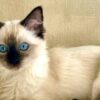Spotlighting – The West Highland White Terrier
Hi everyone and welcome to this spotlight episode on Val Talk’s Pets. In this spotlight episode I’ve chosen to highlight one of my favourite breeds of dogs, and no I’ve […]
 play_arrow
play_arrowHow to Choose the Perfect Name for Your Pet Val Cairney

 play_arrow
play_arrowSpotlight – The Ragdoll Cat Val Cairney
Hi everyone, and welcome to another spotlight edition. On this spotlight I thought I would look at one of the breeds of cats that I hear fairly often that people have or are looking for. And that is the Ragdoll cat.
The Ragdoll is a very pretty cat and to be honest I’ve only seen actual Ragdoll cats at a pet expo where the cat fanciers had a section. They are very striking looking cats with their blue eyes and semi-long silky hair. I guess one of the first questions to address is why are these cats called Ragdolls? They don’t look like dolls! Well apparently cats from the original breeding stock could go limp and relaxed when picked up, or limp like a ragdoll, hence the cats got their name, Ragdoll.

So, when did the Ragdoll make its appearance on the cat stage so to speak? In the 1960’s an American breeder by the name Ann Baker developed this breed. According to the history of Ragdolls, Ann had a regular white longhaired cat who had several litters of kittens. This cat was a sort of a Persian/Angora type cat and the fathers of her litters were Birman or Burmese like cats and one had the Siamese colouration. The kittens apparently were placid and affectionate and had this tendency to go limp when picked up. So, Ann purchased other kittens and set out to create the Ragdoll. Selectively over many years Ann bred her cats for their desirable traits and colouration. Because Ann was selectively breeding, all Ragdolls are descended from her original litters and breeding. What is really interesting, is that Ann decided not to go the traditional route of registering with cat-breeding associations. Instead, she trademarked the name Ragdoll and set up her registry, The International Ragdoll Cat Association. In doing so, she enforced stringent standards on anyone who wanted to breed or sell cats under that name. Since Ann Baker’s death in 1997, the organization is smaller and unfortunately, IRCA cats are not recognized in any major cat breed organization or cat show. But, in 1975 Denny and Laura Dayton and a few others, broke from the International Ragdoll Cat Association to try and get Ragdolls mainstream recognition. This group was able to develop the Ragdoll standard currently accepted by major cat registries. Such as CFA, Cat Fanciers Association and the FIFe, Federation international Feline. Eventually breeding pairs were shipped to the UK and the breed became established there, recognized by the Governing Council of the Cat Fancy. Now, this part is very interesting, in 1994 a second group decided to leave the IRCA and form its own group. Apparently the increasing restrictions on the breed standards became an issue. This group established the Ragamuffin breed. Remember that Ann Baker had trademarked the name Ragdoll, so that meant that no offshoot had rights to the name. But, with Ann Baker no longer alive, the trademark by 2005 was not renewed, and then the name Ragdoll became legal to use. The largest international Ragdoll breed club is the Ragdoll Fanciers Club International.

So, what does a Ragdoll look like? Well they have beautiful blue eyes, and have a V-shaped marking on their forehead. Their coats are soft and thick, so that means regular grooming, and they have thick limbs and long tails. So, they are considered to be powerful and large heavy cats. A female fully grown, weights 8 – 15 pounds and males are larger at 12 – 20 pounds. Their paws are large, round and tufted, so they have really cute silky hair sprouting from their paws. It is interesting that a Ragdoll can take up to 4 years to reach full maturity. Their colouring is commonly, tri-colour or bi-colour. They come in six different colours. Red, Seal, chocolate and the corresponding “dilutes” as they are called which includes blue, lilac and cream.
One of the best things about Ragdolls is that they are pretty hearty and quite relaxed in nature. They are great at following people around so they are like having a little dog hence they are often referred to or known as dog-like cats. They are very non-aggressive and can tolerate things well so they are an ideal pet for a family. They also have a playful nature and can even learn to retrieve toys and make a good game of it.
In terms of health issues or things to look out for, the Ragdoll may possibly have a lower life expectancy living 12 to 15 years, but the studies on this are too specific to certain areas of the globe, so I’m sure some Ragdoll owners can give insight into the age of their cats. It is also possible that kidney or ureter issues may come to light, so something to watch for. In terms of their coat, luckily it doesn’t mat easily, but brushing a few times a week is will help with any mats, shedding and tangles. Generally Ragdolls like their grooming time so this is a great way to show some special attention. Although a Ragdoll loves to follow their humans and are quite social they are not demanding. However, they can develop depression if they are not getting adequate attention.
It is often recommended that a Ragdoll have another cat in the household. Signs to look for that a Ragdoll is experiencing depression would be, destructive behaviour, over sleeping, over or under grooming, eating issues, or generally a low depressed mood.

Now, one of the more significant things to look into, is Hypertrophic cardiomyopathy or HCM. This is a common heart disease in all cats and is commonly genetic in cause. This is a thickening of the heart wall which makes the heart pump less efficiently. It can lead to sudden death in some cases. Ragdolls that are positive for the disease, meaning they have two copies of the HCM gene, can present as early as six months with most cats dying by age 3. A cat that has one copy of the HCM gene tend to have later onset and a slower progression with less severe impact. In 2007 a DNA test was developed to identify the gene that causes HCM. It is important that breeding be done only with cats that are free of the HCM gene so the disease is not perpetuated.
Overall, the Ragdoll is a lovely larger cat that can handle a family, be a good social part of the group but not overwhelm with clinginess. They are fairly easy care when it comes to grooming and the thing to look out for is Hypertrophic Cardiomyopathy.
So that leads me to a very short pet peeves section.
I think the only thing to peeve about here, would be about people who want to jump on the popularity of the Ragdoll and breed indiscriminately. And as we know, that is a common issue with all breeding be it cats or dogs. A good breeder should be a part of a recognized registration and the DNA test for the HCM gene should be provided. If this is in place, then you can justify the cost of one of these lovely cats. If this is not in place, then a seller is really not acting reputably and buying a kitten from such seller means that the cycle of bad breeding keeps going and the risk of a serious health issue is not being monitored or controlled. So, don’t be one of those people and do your homework and expect the utmost standards because, as I say, know is caring.
For the price of a coffee, or more if you are feeling generous, you can help keep this podcast going & growing. Please visit my ko-fi page to make a donation. Thanks for all your support!
Please remember to follow or subscribe to ensure that you never miss an episode.
Please don’t forget to Rate and Review each episode that you find helpful/educational. By doing so you will help others find Val Talks Pets.
Email me at: val@valtalkspets.com with topics you think would be of interest or with any questions you may have.
Also, visit and be a part of my website at valtalkspets.com and help it grow!
Thanks for listening!
Tagged as: cat breeds, ragdoll cat, purebred cats.
Hi everyone, and welcome to Val Talk’s Pets, the forum for pet parents and enthusiasts alike. So, I have been working in the pet industry now for almost 10 years and, on a daily basis, I handle a lot of issues and questions arising from pet parents. I am not a veterinarian but I do have certifications in Canine, Feline, Small Animal, Fish and Herptile and Avian Health and Nutrition from the University of California, Davis Extension, the Vet College.
Val Cairney September 17, 2021
Hi everyone and welcome to this spotlight episode on Val Talk’s Pets. In this spotlight episode I’ve chosen to highlight one of my favourite breeds of dogs, and no I’ve […]
Val Cairney August 29, 2025
Val Cairney August 15, 2025
For the price of a coffee, or more if you are feeling generous, you can help keep this podcast going & growing. Please visit my ko-fi page to make a donation. Thanks!
all rights reserved - Val Talks Pets - 2024